Custom Bilstein Build Up Thread
#1
road warrior
Thread Starter
Join Date: Feb 2006
Location: Oakland and Los Angeles, CA
Posts: 1,861
Likes: 0
Received 3 Likes
on
3 Posts
Custom Bilstein Build Up Thread
Since my thread got deleted by the mods yesterday, let's try this again.
First off, this is a thread detailing my suspension build up with FatCatMotorsports. I am NOT trying to sell anything nor do I gain anything if interests generate more sales for FatCat. Rather, I feel that the RX-8 community might benefit from the research done in my build-up and this would be a good place to debate what direction to take. Also, if sufficient interest is shown in the application, the engineering might be taken with an eye towards a bigger run for those interested.
Right now everything is up in the air. I've purchased some Bilstein HD dampers, which will probably be revalved. My goal is to improve the handling while trying to maintain the compliance of the car over midcorner bumps. As it is, I'm shooting for a rate of something like 300/225, though whether I'll go with custom wound springs or simply use coilover sleeves for 2.5" ID springs is unknown. Most likely I'll go with the sleeve solution as it offers me the potential to adjust ride height and makes spring changing easier in the future. We shall see, so far the base dampers haven't even been delivered yet.
First off, this is a thread detailing my suspension build up with FatCatMotorsports. I am NOT trying to sell anything nor do I gain anything if interests generate more sales for FatCat. Rather, I feel that the RX-8 community might benefit from the research done in my build-up and this would be a good place to debate what direction to take. Also, if sufficient interest is shown in the application, the engineering might be taken with an eye towards a bigger run for those interested.
Right now everything is up in the air. I've purchased some Bilstein HD dampers, which will probably be revalved. My goal is to improve the handling while trying to maintain the compliance of the car over midcorner bumps. As it is, I'm shooting for a rate of something like 300/225, though whether I'll go with custom wound springs or simply use coilover sleeves for 2.5" ID springs is unknown. Most likely I'll go with the sleeve solution as it offers me the potential to adjust ride height and makes spring changing easier in the future. We shall see, so far the base dampers haven't even been delivered yet.
#2
road warrior
Thread Starter
Join Date: Feb 2006
Location: Oakland and Los Angeles, CA
Posts: 1,861
Likes: 0
Received 3 Likes
on
3 Posts
So I ordered the Bilstein HDs from tirerack; shox.com has lower prices, but since they're located in California the sales tax would've negated everything and I've always had great service from tirerack, so I decided to go with what I knew. I think I'm going to get the HDs dyno'd to get a baseline and figure out what off the shelf HDs are capable of. This will be very interesting.
#3
Hi Lionzoo,
Are you going to try the OTS Bilsteins with the stock springs before you revalve and change springs? I'd be interested in hearing your impressions of the HD as a simple replacement for the original shocks.
Also, what are you doing in Pasadena? I did my undergrad and graduate studies at Caltech.
Are you going to try the OTS Bilsteins with the stock springs before you revalve and change springs? I'd be interested in hearing your impressions of the HD as a simple replacement for the original shocks.
Also, what are you doing in Pasadena? I did my undergrad and graduate studies at Caltech.
#4
road warrior
Thread Starter
Join Date: Feb 2006
Location: Oakland and Los Angeles, CA
Posts: 1,861
Likes: 0
Received 3 Likes
on
3 Posts
Hi Lionzoo,
Are you going to try the OTS Bilsteins with the stock springs before you revalve and change springs? I'd be interested in hearing your impressions of the HD as a simple replacement for the original shocks.
Also, what are you doing in Pasadena? I did my undergrad and graduate studies at Caltech.
Are you going to try the OTS Bilsteins with the stock springs before you revalve and change springs? I'd be interested in hearing your impressions of the HD as a simple replacement for the original shocks.
Also, what are you doing in Pasadena? I did my undergrad and graduate studies at Caltech.
I live around Pasadena. If I were going to Caltech right now, I don't think I could afford the mods.
#5
road warrior
Thread Starter
Join Date: Feb 2006
Location: Oakland and Los Angeles, CA
Posts: 1,861
Likes: 0
Received 3 Likes
on
3 Posts
We did bounce frequency tests last night. The frequency we got for my car (2006 base, around 2930 pounds total at the time of the test) was 1.35 Hz for the front and 1.47 Hz for the back. What this means is that the rear has a higher natural frequency and so the car will tend to want to come down as a unit when it hits bumps. This makes the car smoother and more predictable over bumps and is a quality that I wish to keep.
We weren't able to dyno the Bilstein HDs, but Shaikh does have the dyno plot for the stock dampers.
We weren't able to dyno the Bilstein HDs, but Shaikh does have the dyno plot for the stock dampers.
Last edited by LionZoo; 10-01-2008 at 04:37 PM.
#6
is adjusting valve lash
Join Date: Sep 2007
Location: hollywooood!
Posts: 1,060
Likes: 0
Received 0 Likes
on
0 Posts
1.35fr and 1.47rr huh? seems like the fronts with lower frequency than the rears will act like its softer... so like u said, more willing to turn in, very good for autox eh?
OR, is this what u were looking for to minimize pitching?
anyways lion, good job. seems like you're on the track to a nice build suspension i'm sure. i can't wait to see some results! just be sure to go over some of ur findings and special areas... this is interesting!
GL on the rest of the project. i'll stayed tuned on ur progress =)
OR, is this what u were looking for to minimize pitching?
anyways lion, good job. seems like you're on the track to a nice build suspension i'm sure. i can't wait to see some results! just be sure to go over some of ur findings and special areas... this is interesting!
GL on the rest of the project. i'll stayed tuned on ur progress =)
#7
Registered User
Join Date: May 2007
Location: San Jose
Posts: 11
Likes: 0
Received 0 Likes
on
0 Posts
Frequencies for Lian's unladen, essentially stock (~5lb lighter wheel) were 1.38 / 1.47 Hz front/rear, or about 6% higher rear than front. This relationship also exists on the NC with nearly the same frequencies (kind of a nice, likely non-random result!). Higher rear than front freq. does improve ride quality, reduce pitching, and improves vehicle dynamics (the rear springs, being stiffer, 'lead' the front). For Miatas, I've found that 10% seems a good range for highway speeds. The RX-8 may need a bit higher ratio due to the longer wheelbase. We'll repeat the bounce tests for at least one if not a few different spring rates on Lian's car to help develop some empirical motion ratio values.
Does anyone know how similar the NC and RX-8 control arms/subframes are? I also noted that the front shock assemblies were nearly identical between NC and RX-8. Most mounting hardware was the same although the RX-8 upper and lower bushings are *slightly* shorter and wider than the NC. Rear RX-8 shock hat is about 2" taller vs NC. Looking at the rear hat where the spring sits, the OD of the raised wall/tube is identical, but they taper down differently - the RX-8 having a more vertical wall due to the thicker spring coil. A picture would help illustrate this (none taken yet).
No Bilstein HD plots until I turn a different dyno adapter on the lathe. Following are the OE Tokicos and Koni Sports with some comparisons of average F vs. V and full-loop F vs. V (interesting behavior shows up! )
)
Shaikh
FRONT
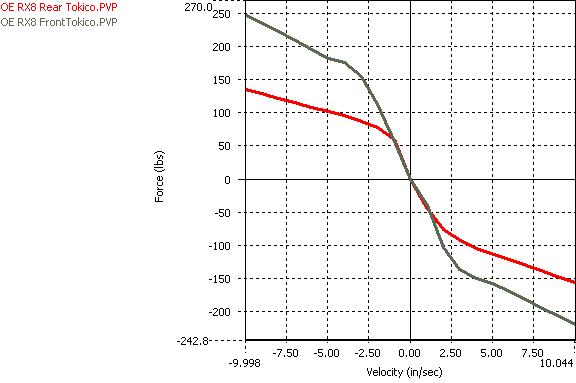
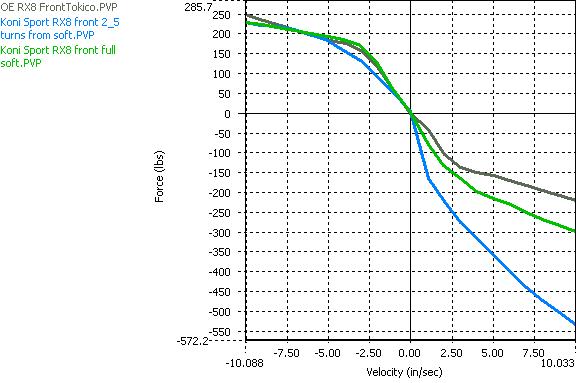
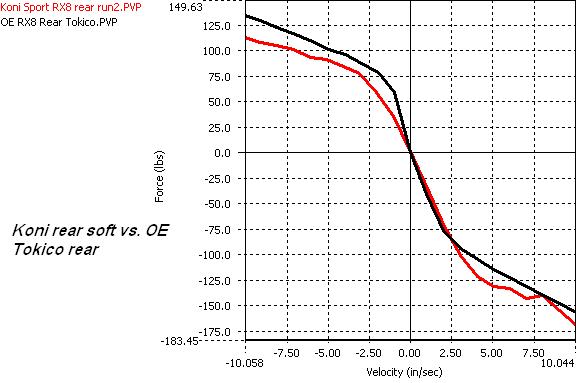
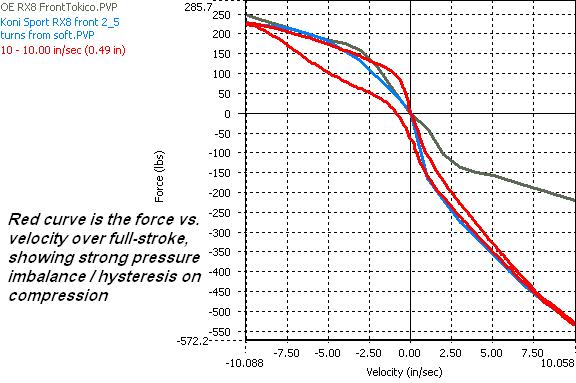
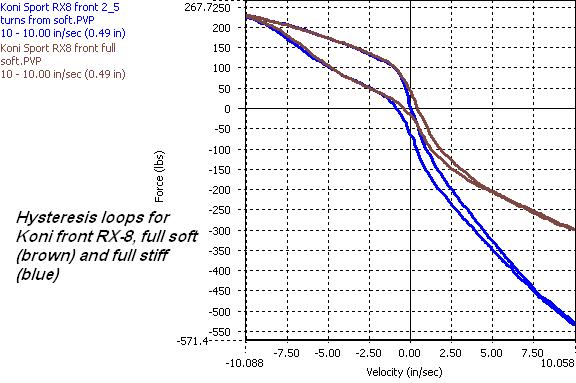
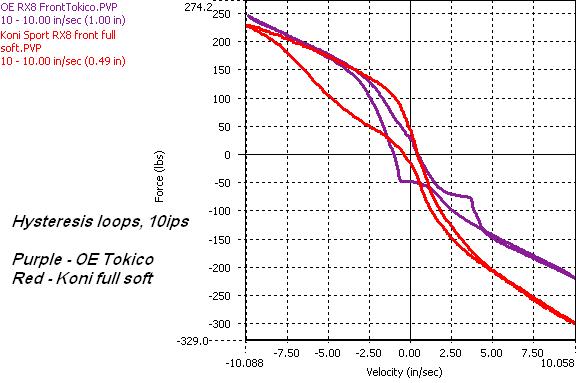
REAR
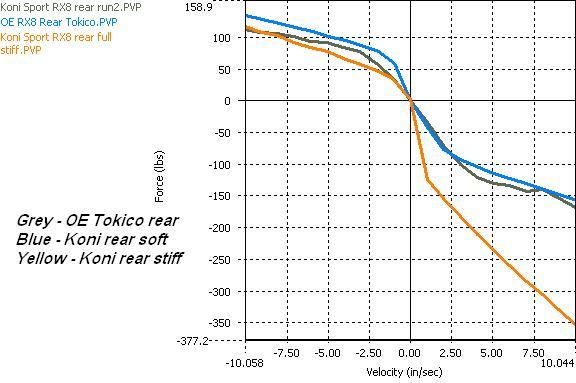
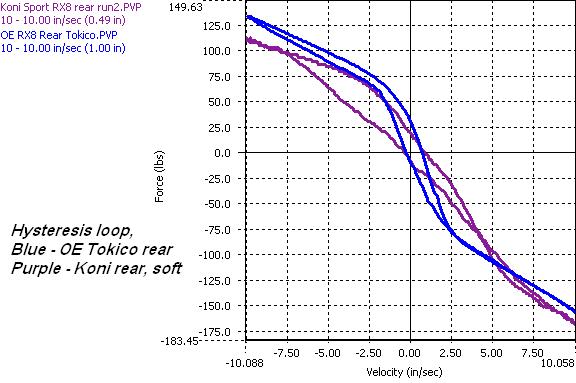
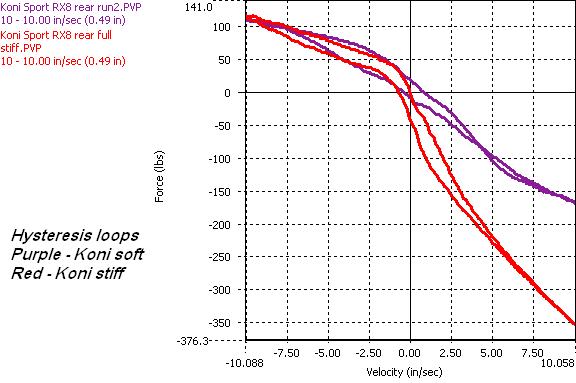
Does anyone know how similar the NC and RX-8 control arms/subframes are? I also noted that the front shock assemblies were nearly identical between NC and RX-8. Most mounting hardware was the same although the RX-8 upper and lower bushings are *slightly* shorter and wider than the NC. Rear RX-8 shock hat is about 2" taller vs NC. Looking at the rear hat where the spring sits, the OD of the raised wall/tube is identical, but they taper down differently - the RX-8 having a more vertical wall due to the thicker spring coil. A picture would help illustrate this (none taken yet).
No Bilstein HD plots until I turn a different dyno adapter on the lathe. Following are the OE Tokicos and Koni Sports with some comparisons of average F vs. V and full-loop F vs. V (interesting behavior shows up!
 )
)Shaikh
FRONT






REAR



Last edited by Shaikh@FatCatMotorsports; 07-04-2008 at 04:25 AM.
#8
road warrior
Thread Starter
Join Date: Feb 2006
Location: Oakland and Los Angeles, CA
Posts: 1,861
Likes: 0
Received 3 Likes
on
3 Posts
Just a small tidbit of extra news; most likely we'll go with Swift coilover springs for my build since I found a place that offers them for a decent price and it seems people that have them really like them.
#13
Registered User
Join Date: Nov 2006
Location: Sunnyvale, CA
Posts: 15
Likes: 0
Received 0 Likes
on
0 Posts
Please instruct/enlighten me if I'm wrong or ignorant on any of this! I'm near San Jose (Sunnyvale) - I'm interested in getting these myself if they work out well - they seem like a good setup for these crappy California roads.
#14
road warrior
Thread Starter
Join Date: Feb 2006
Location: Oakland and Los Angeles, CA
Posts: 1,861
Likes: 0
Received 3 Likes
on
3 Posts
The advantage to this exercise is I can get exactly what I want; I can set the damping (if I choose to revalve) and pick out what spring rates I want. Swift springs was just something that I want to try for curiosity's sake; they don't make or break the kit. The disadvantage is that since I'm starting out with the Bilstein HD, it won't have adjustable damping unless I want to pay for that as well, in which case it will be more expensive than the PSS9 kit.
If you're curious about this kit, we're planning to do stage 1 install either tomorrow or Friday night in San Jose. Stage 1 is mainly for testing; it'll be the stock Bilstein HD with the sleeves and a spring rate about that mentioned in the first post. Shaikh tells me that the HDs are valved to be able to damp the spring without any changes; we'll see if that's really the case. The Swift springs won't go on until we have the spring rate and length sorted. PM me your phone number and I can see if we can work out an arrangement where you can come and watch and bug Shaikh with questions if you wish.
If you're curious about this kit, we're planning to do stage 1 install either tomorrow or Friday night in San Jose. Stage 1 is mainly for testing; it'll be the stock Bilstein HD with the sleeves and a spring rate about that mentioned in the first post. Shaikh tells me that the HDs are valved to be able to damp the spring without any changes; we'll see if that's really the case. The Swift springs won't go on until we have the spring rate and length sorted. PM me your phone number and I can see if we can work out an arrangement where you can come and watch and bug Shaikh with questions if you wish.
#15
road warrior
Thread Starter
Join Date: Feb 2006
Location: Oakland and Los Angeles, CA
Posts: 1,861
Likes: 0
Received 3 Likes
on
3 Posts
So an update: we weren't able to get the parts done in time for me to install on this trip up. Shaikh will finish the parts and either send them to me or we'll install them next time I have the RX-8 up.
An interesting tidbit is that we're going to go with a first cut springrate of 300/300 F/R. That's right; the springrate will be even front to rear. We settled on this springrate to get the ride frequency we want. Of course everything is first cut for now, but I find it rather surprising that our calculations gave this result. Perhaps it's a piece of vindication for the Bilstein engineers who selected the rates for the PSS9...
An interesting tidbit is that we're going to go with a first cut springrate of 300/300 F/R. That's right; the springrate will be even front to rear. We settled on this springrate to get the ride frequency we want. Of course everything is first cut for now, but I find it rather surprising that our calculations gave this result. Perhaps it's a piece of vindication for the Bilstein engineers who selected the rates for the PSS9...
Last edited by LionZoo; 08-12-2008 at 06:01 PM.
#16
ALL HAIL GLORY
iTrader: (1)
Join Date: Apr 2007
Location: huntington beach
Posts: 20
Likes: 0
Received 0 Likes
on
0 Posts
can someone clarify a few things for me in this thread?
-what is PVP?
-what does 10 - 10.00 in/sec (0.49 in) mean?
-what is being illustrated by the hysteresis loops? is it a range of "actual" damping?
-positive velocity / negative force is compression or rebound on these charts?
-"We did bounce frequency tests last night. The frequency we got for my car (2006 base, around 2930 pounds total at the time of the test) was 1.35 Hz for the front and 1.47 Hz for the back. What this means is that the car is more willing to turn during transient situations like turn in, but at steady state, like midcorner, can be set up for a bit more understeer." - Lionzoo
this is the first time i've heard of the bounce frequency test. can you explain a little more about it? how do higher/lower frequencies for front/rear affect handling and ride comfort? i understand there may be an ideal ratio front to rear, from what Shaikh is implying, but beyond that, i have no clue.
-what is PVP?
-what does 10 - 10.00 in/sec (0.49 in) mean?
-what is being illustrated by the hysteresis loops? is it a range of "actual" damping?
-positive velocity / negative force is compression or rebound on these charts?
-"We did bounce frequency tests last night. The frequency we got for my car (2006 base, around 2930 pounds total at the time of the test) was 1.35 Hz for the front and 1.47 Hz for the back. What this means is that the car is more willing to turn during transient situations like turn in, but at steady state, like midcorner, can be set up for a bit more understeer." - Lionzoo
this is the first time i've heard of the bounce frequency test. can you explain a little more about it? how do higher/lower frequencies for front/rear affect handling and ride comfort? i understand there may be an ideal ratio front to rear, from what Shaikh is implying, but beyond that, i have no clue.
#17
road warrior
Thread Starter
Join Date: Feb 2006
Location: Oakland and Los Angeles, CA
Posts: 1,861
Likes: 0
Received 3 Likes
on
3 Posts
can someone clarify a few things for me in this thread?
-what is PVP?
-what does 10 - 10.00 in/sec (0.49 in) mean?
-what is being illustrated by the hysteresis loops? is it a range of "actual" damping?
-positive velocity / negative force is compression or rebound on these charts?
-"We did bounce frequency tests last night. The frequency we got for my car (2006 base, around 2930 pounds total at the time of the test) was 1.35 Hz for the front and 1.47 Hz for the back. What this means is that the car is more willing to turn during transient situations like turn in, but at steady state, like midcorner, can be set up for a bit more understeer." - Lionzoo
this is the first time i've heard of the bounce frequency test. can you explain a little more about it? how do higher/lower frequencies for front/rear affect handling and ride comfort? i understand there may be an ideal ratio front to rear, from what Shaikh is implying, but beyond that, i have no clue.
-what is PVP?
-what does 10 - 10.00 in/sec (0.49 in) mean?
-what is being illustrated by the hysteresis loops? is it a range of "actual" damping?
-positive velocity / negative force is compression or rebound on these charts?
-"We did bounce frequency tests last night. The frequency we got for my car (2006 base, around 2930 pounds total at the time of the test) was 1.35 Hz for the front and 1.47 Hz for the back. What this means is that the car is more willing to turn during transient situations like turn in, but at steady state, like midcorner, can be set up for a bit more understeer." - Lionzoo
this is the first time i've heard of the bounce frequency test. can you explain a little more about it? how do higher/lower frequencies for front/rear affect handling and ride comfort? i understand there may be an ideal ratio front to rear, from what Shaikh is implying, but beyond that, i have no clue.
-Wild guess: 10 loops at 10 in/sec with an amplitude of 0.49 in
-Hysteresis loop is showing how a damper fades. Twintubes like the Koni SA especially have this problem; since there is no barrier between their pressurized gas and shock fluid, lots of suspension movement tends to result in the gas mixing with the fluid, causing the damping to vary and become inconsistent. However, as can be seen in the dyno, even high pressure monotubes will have some disturbance to the shock oil and results in hysteresis.
-Positive is bound, negative is rebound.
-The bounce frequency test measures at what frequency a car wants to vibrate at per end over bumps and disturbances. This gives a general idea of a car's ride behavior. Higher frequencies are harsher, a higher rear frequency is often used to make the car bounce once over bumps as a unit instead of bouncing as two different axles. Of course this doesn't take into account sway bars, but a higher rear frequency will have a tendency for the rear end to react faster than the front, causing the vehicle turn-in better. Of course too much means an oversteering car, so it's a balancing act.
#18
ALL HAIL GLORY
iTrader: (1)
Join Date: Apr 2007
Location: huntington beach
Posts: 20
Likes: 0
Received 0 Likes
on
0 Posts
-PVP I think is the file format for the shock dyno.
-Wild guess: 10 loops at 10 in/sec with an amplitude of 0.49 in
-Hysteresis loop is showing how a damper fades. Twintubes like the Koni SA especially have this problem; since there is no barrier between their pressurized gas and shock fluid, lots of suspension movement tends to result in the gas mixing with the fluid, causing the damping to vary and become inconsistent. However, as can be seen in the dyno, even high pressure monotubes will have some disturbance to the shock oil and results in hysteresis.
-Positive is bound, negative is rebound.
-The bounce frequency test measures at what frequency a car wants to vibrate at per end over bumps and disturbances. This gives a general idea of a car's ride behavior. Higher frequencies are harsher, a higher rear frequency is often used to make the car bounce once over bumps as a unit instead of bouncing as two different axles. Of course this doesn't take into account sway bars, but a higher rear frequency will have a tendency for the rear end to react faster than the front, causing the vehicle turn-in better. Of course too much means an oversteering car, so it's a balancing act.
-Wild guess: 10 loops at 10 in/sec with an amplitude of 0.49 in
-Hysteresis loop is showing how a damper fades. Twintubes like the Koni SA especially have this problem; since there is no barrier between their pressurized gas and shock fluid, lots of suspension movement tends to result in the gas mixing with the fluid, causing the damping to vary and become inconsistent. However, as can be seen in the dyno, even high pressure monotubes will have some disturbance to the shock oil and results in hysteresis.
-Positive is bound, negative is rebound.
-The bounce frequency test measures at what frequency a car wants to vibrate at per end over bumps and disturbances. This gives a general idea of a car's ride behavior. Higher frequencies are harsher, a higher rear frequency is often used to make the car bounce once over bumps as a unit instead of bouncing as two different axles. Of course this doesn't take into account sway bars, but a higher rear frequency will have a tendency for the rear end to react faster than the front, causing the vehicle turn-in better. Of course too much means an oversteering car, so it's a balancing act.
Lion, thanks!
- "10 loops at 10 in/sec with an amplitude of 0.49 in "
ahhh ok that makes sense now. its +/- 10 in/sec maximum piston velocity. looking at the charts, those are the max/min values on the x-axis.
- "Positive is bound, negative is rebound."
i think its the opposite? actually depends on what we are talking about. positive velocity/negative force (lower right quadrant) is rebound. we can confirm that for 2 reasons. 1, konis are rebound adjustable only. so looking at the koni graph, you can see the change from full soft to 2.5 turns from full soft. 2, shaikh's comment on the 1st hysteresis graph (front koni 2.5 turns) about large change on compression.
- bounce frequency
wouldnt this depend highly on damping? seems to me that higher damping forces would lower bounce frequency, and reduce turning response time (reacts faster). how can we conclude that a higher frequency means harsher ride and faster response?
#19
road warrior
Thread Starter
Join Date: Feb 2006
Location: Oakland and Los Angeles, CA
Posts: 1,861
Likes: 0
Received 3 Likes
on
3 Posts
Lion, thanks!
- "10 loops at 10 in/sec with an amplitude of 0.49 in "
ahhh ok that makes sense now. its +/- 10 in/sec maximum piston velocity. looking at the charts, those are the max/min values on the x-axis.
- "Positive is bound, negative is rebound."
i think its the opposite? actually depends on what we are talking about. positive velocity/negative force (lower right quadrant) is rebound. we can confirm that for 2 reasons. 1, konis are rebound adjustable only. so looking at the koni graph, you can see the change from full soft to 2.5 turns from full soft. 2, shaikh's comment on the 1st hysteresis graph (front koni 2.5 turns) about large change on compression.
- bounce frequency
wouldnt this depend highly on damping? seems to me that higher damping forces would lower bounce frequency, and reduce turning response time (reacts faster). how can we conclude that a higher frequency means harsher ride and faster response?
- "10 loops at 10 in/sec with an amplitude of 0.49 in "
ahhh ok that makes sense now. its +/- 10 in/sec maximum piston velocity. looking at the charts, those are the max/min values on the x-axis.
- "Positive is bound, negative is rebound."
i think its the opposite? actually depends on what we are talking about. positive velocity/negative force (lower right quadrant) is rebound. we can confirm that for 2 reasons. 1, konis are rebound adjustable only. so looking at the koni graph, you can see the change from full soft to 2.5 turns from full soft. 2, shaikh's comment on the 1st hysteresis graph (front koni 2.5 turns) about large change on compression.
- bounce frequency
wouldnt this depend highly on damping? seems to me that higher damping forces would lower bounce frequency, and reduce turning response time (reacts faster). how can we conclude that a higher frequency means harsher ride and faster response?
-Yeah I was saying negative force is rebound.
-It wouldn't; you're looking for the harmonic of the springs. Remember that damping controls amplitude, but not frequency. Here you're trying to find frequency.
Last edited by LionZoo; 10-01-2008 at 04:40 PM.
#21
road warrior
Thread Starter
Join Date: Feb 2006
Location: Oakland and Los Angeles, CA
Posts: 1,861
Likes: 0
Received 3 Likes
on
3 Posts
You get a few guys to push one end of the car up and down and measure the frequency that the movement seems to settle at. You don't let go of the car; rather you keep pushing with every stroke. The car will want to settle at a frequency and pretty soon that is the rhythm that you're pushing the car at.
#22
road warrior
Thread Starter
Join Date: Feb 2006
Location: Oakland and Los Angeles, CA
Posts: 1,861
Likes: 0
Received 3 Likes
on
3 Posts
Did a bounce frequency test on Rotary Rocket's car, with very interesting results. On Tein Flexes, we recorded a 2.2 Hz front and a 2.0 Hz rear bounce frequency.
#25
road warrior
Thread Starter
Join Date: Feb 2006
Location: Oakland and Los Angeles, CA
Posts: 1,861
Likes: 0
Received 3 Likes
on
3 Posts
Update on the build: we are going to revalve the Bilsteins and get a curve that is much better for our application. After doing some damping calculations, it seems that the Bilstein HDs are pretty good for the stock springs in front, and decent for the rates I want to run. The stock dampers are even a bit higher in damping than what is needed in the front and the Konis copy that curve, except they jack up the rebound by quite a bit if you turn them off full soft. The Bilstein HDs are also slightly higher in rebound than is optimum, but a lot of people like the feeling of having more rebound than compression damping and that is a school of thought in terms of suspension design.
However, the rears are pretty underdamped. The stock dampers are underdamped and apparently both Koni and Bilstein (and probably Tokico as well) seemed to have copied the general curve, though the Koni has a lot more rebound. Because of this, we would probably need to revalve the rears and since we're going to be doing the rears, we might as well do the fronts as well.
In addition to the dampers, we have a prototype built for the rear upper perch adapter; 2.5" springs don't fit onto the factory perch. Over the weekend I'm going to refine the design and run some analysis to confirm the strength and durability of the perch. There has been some interesting findings in this build, and I'm sure there will be more as we go along.
However, the rears are pretty underdamped. The stock dampers are underdamped and apparently both Koni and Bilstein (and probably Tokico as well) seemed to have copied the general curve, though the Koni has a lot more rebound. Because of this, we would probably need to revalve the rears and since we're going to be doing the rears, we might as well do the fronts as well.
In addition to the dampers, we have a prototype built for the rear upper perch adapter; 2.5" springs don't fit onto the factory perch. Over the weekend I'm going to refine the design and run some analysis to confirm the strength and durability of the perch. There has been some interesting findings in this build, and I'm sure there will be more as we go along.

